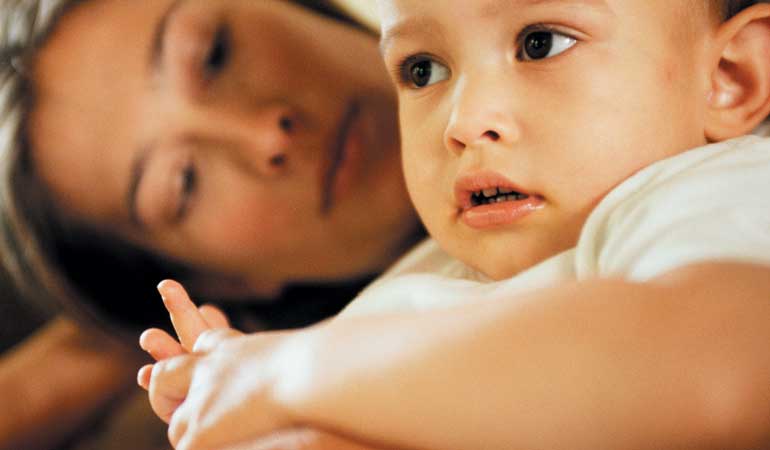“Vic has difficulty using adjectives and pronouns, and sometimes it sounds as if he doesn’t know the difference between male and female.”
“Our son, Camden, never jabbered. He would learn a few words and then we’d hear nothing. Time would go by and we would hear a new word, then not hear it again. It was if he were learning them, storing them, and moving on.”
Like a child’s first steps, first words are a milestone that parents eagerly await. Typically, other words quickly follow, as the child learns the power of speech and masters the rules of language. By age three or four, most children are adept at expressing themselves, are fairly understandable, and need to be reminded that someone else might have something to say.
But some children encounter difficulty expressing themselves, calling objects by the wrong name, or saying words that are hard to understand. Others may be unable to make sense of what is said to them. Speech and language skills are critical for young children as they begin to enter the world around them. Even a mild delay in language development may result in tantrums, interfere with learning, sabotage social skills, and undermine self-esteem.
According to the National Institute on Deafness and Other Communication Disorders, more than 10 percent of all preschool children have some form of language impairment. Studies show that as many as half the children in foster care have speech or language delays.
And according to Dr. Jane Aronson, a pediatrician specializing in international adoption, the majority of children who previously lived in orphanages have speech and language delays at the time of adoption. The good news is that, with early intervention, the great majority of language-delayed children will be successfully helped in their long-term language development.
Role of Early “Conversations”
One of the most important factors in language development is exposure to meaningful speech during the first three years of life. A baby learns the value of communication in the first few days of life, when her cry brings food and comfort. A child soon recognizes the voice of her parent(s) or caregivers and starts to sort out the building blocks that compose the words of her native language.
But some children who join their families through adoption may have missed out on this intimate back-and-forth between child and caregiver. According to Dr. Aronson, “Children raised in institutions miss the eye contact, constant touching, and reciprocal communication needed for brain development at this age.”
The same is true for children who lived previously in homes with little stimulation or language directed towards the child. Reading and singing to children play an important role in language development, as does holding a child for her bottle. When no one responds to a child’s babble, she learns that her voice does not matter, and may not progress in language development.
Types of Language Delays
Although many people think of speech as a collection of words, much more is involved in communicating with others. Some children experience problems with the mechanics of speech.
Most common are difficulties with articulation, the correct use of the tongue, lips, and jaw to produce the right sounds. Stuttering, lisping, breathiness, and sudden breaks in loudness or pitch may also make a child hard to understand.
Expressive language may also be an issue. Some children identify objects by the wrong names, jumble the order of words in a sentence, or have limited vocabulary. Other children may have trouble receiving language: although their hearing is fine, they are unable to make sense of certain words or sentences.
Even children who have language skills in their native tongue can run into problems, says Sharon Glennen, Ph.D., associate professor of Communications Sciences & Disorders at Towson University in Maryland. When faced with an abrupt change of language, internationally adopted children typically relinquish their first language while learning another. As a result, certain developmental and linguistic problems may emerge.
Some children will need help adjusting to new sounds, especially if their previous learning environment was inadequate. Others, particularly those adopted after age three, may experience delay with the abstract thought and cognitive skills needed for academic achievement, says Jeanne DeTemple, Ph.D., a developmental psychologist in Concord, Massachusetts.
That’s because they are busy re-acquiring language for communication purposes — a task that takes up to three years — at a time when they would otherwise be developing reasoning skills.
Fortunately, mild developmental language delays caused by poor orphanage conditions often recede. In recent studies by Glennen and Karen Pollack of the Department of Speech Pathology & Audiology, University of Alberta, the vast majority of preschool-aged children from China and Eastern Europe made good progress in speech and language within two years of adoption.
For children whose delays are more severe, speech therapy can produce great strides. “Our sons weren’t saying any words by their second birthday, though they understood everything we said,” recalls Shannon Seymour, the mother of twins adopted abroad as infants. “Now, after ten months of speech therapy, we can’t get them to stop talking.”
Getting Started
Before communication issues can be addressed, families must determine whether their child is able to hear. Hearing loss, either permanent or temporary, interferes with a child’s developing ability to speak and comprehend language.
Children with ear infections often hold fluid behind their eardrums for extended periods of time. Sounds become muffled and indistinct. Other children may have difficulty coordinating the muscles in their mouths.
Parents, who speak with their children daily, are the first to notice problems but may be uncertain as to how to proceed, says Diane Paul-Brown of the American Speech-Language-Hearing Association (ASHA). Although some delays go away with the passage of time, Paul-Brown strongly advocates early intervention.
Getting Help
In addressing speech and language concerns, many families start by consulting their child’s physician, who can help to determine if the child is on target for his age. A child should have a hearing screen and examination of the mouth to ensure there are not medical reasons for limited language production.
When a child’s hearing is normal, it may be reasonable to wait two to three months to see if he catches up, says Dr. Aronson. “But if delays are dramatic, or the child’s language isn’t improving, don’t continue to ‘wait and see.’ We have to be aggressive about treatment.”
Many experts now recommend that children adopted internationally after the age of two be evaluated in their native language within three months of arriving home. This evaluation should include not only words and diction, but also the structure and understanding of spoken language.
If a child is not speaking or understanding his mother tongue, language delays will affect his ability to learn the language of his new family. Children who have not have yet mastered their first, native language require language intervention above and beyond English as a Second Language (ESL).
Speech Services — Public and Private
Under the Individuals with Disabilities Education Act (IDEA), a child suspected of speech delays is eligible for a publicly funded evaluation. If found in need of treatment, a child may be eligible for services through several age-based programs.
Children up to three years of age are usually treated through the Early Intervention program in their homes or in a day-care setting. In some states these services are free; in others, fees may be based on family income.
Preschool children are typically treated in a classroom setting, while elementary school children receive treatment from a school professional. These programs are free, but they require an evaluation by the school system.
For children not eligible for public services, parents should seek a referral to a private, licensed speech-language pathologist (SLP), preferably one who is certified by the American Speech-Language-Hearing Association (ASHA).
Many insurance companies cover speech therapy; however, some pay only for delays that are shown to be medically or neurologically based, rather than developmental in nature. In some states, adoption subsidies may be available to assist with the expense of such services.
Speech and language evaluations include a comprehensive medical and developmental history, including questions about a child’s language milestones, past illnesses, birth family, and care before adoption. The SLP should also examine the mouth to ensure that there are no medical problems, such as tongue-tie, that interfere with sound production.
Speech and language assessments usually include phonology (making and understanding sounds), semantics (word meaning), syntax (word order), morphology (word forms), and pragmatics (social language).
Following an evaluation, the speech therapist will put together a treatment plan tailored to a child’s unique needs. For children under three years old, the programs are usually home-based. Families are given individualized instruction for working with their child. An older child may work with the therapist individually or as part of a group of children.
Typically, therapy involves a variety of exercises: repeating sounds, playing naming games, or encouraging interactive speech and dialogue. Families are often given specific activities to continue at home to aid in ongoing language development.
Most children enjoy speech therapy. Good speech-language pathologists create fun activities, such as blowing through a straw or making silly sounds. Given the linkage of language to self-esteem, it is important to elicit cooperation in a positive manner.
“Going to speech once a week makes my daughter more willing to practice her exercises at home,” explains Dana Moock, whose daughter was adopted from Vietnam. “Her speech therapist points out her strengths and celebrates each accomplishment.”
The bottom line: most children show improvement with intervention, whether through a home program, individualized private program, or school-based services. Families need to work hand-in-hand with health and school professionals to identify and address delays early, rather than waiting to see if they subside. We cannot overestimate the value of language to a child. He may need help, hard work, and celebrations along the way, but the results will be something to talk about.


